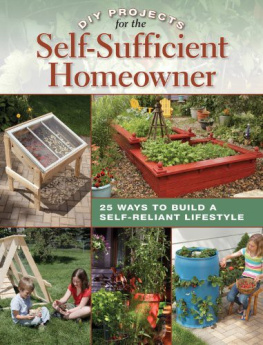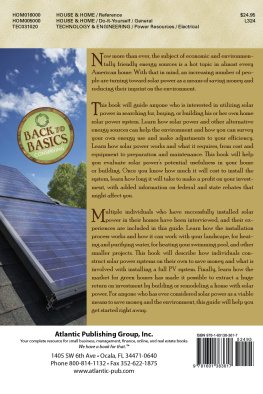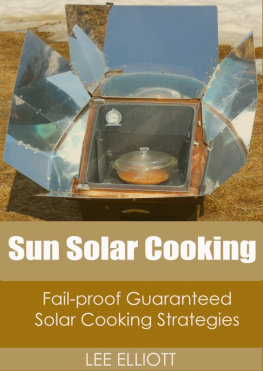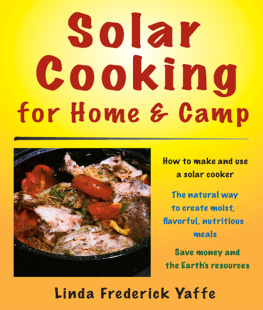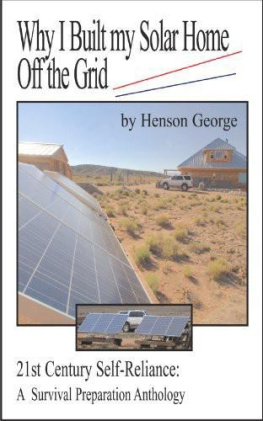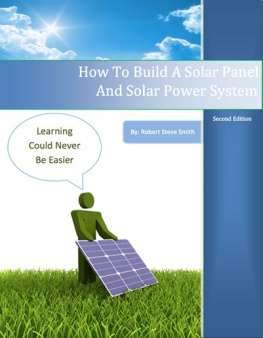Eric Smith - DIY Solar Projects: How to Put the Sun to Work in Your Home
Here you can read online Eric Smith - DIY Solar Projects: How to Put the Sun to Work in Your Home full text of the book (entire story) in english for free. Download pdf and epub, get meaning, cover and reviews about this ebook. year: 2011, publisher: Creative Publishing International, genre: Home and family. Description of the work, (preface) as well as reviews are available. Best literature library LitArk.com created for fans of good reading and offers a wide selection of genres:
Romance novel
Science fiction
Adventure
Detective
Science
History
Home and family
Prose
Art
Politics
Computer
Non-fiction
Religion
Business
Children
Humor
Choose a favorite category and find really read worthwhile books. Enjoy immersion in the world of imagination, feel the emotions of the characters or learn something new for yourself, make an fascinating discovery.
- Book:DIY Solar Projects: How to Put the Sun to Work in Your Home
- Author:
- Publisher:Creative Publishing International
- Genre:
- Year:2011
- Rating:4 / 5
- Favourites:Add to favourites
- Your mark:
- 80
- 1
- 2
- 3
- 4
- 5
DIY Solar Projects: How to Put the Sun to Work in Your Home: summary, description and annotation
We offer to read an annotation, description, summary or preface (depends on what the author of the book "DIY Solar Projects: How to Put the Sun to Work in Your Home" wrote himself). If you haven't found the necessary information about the book — write in the comments, we will try to find it.
DIY Solar Projects: How to Put the Sun to Work in Your Home — read online for free the complete book (whole text) full work
Below is the text of the book, divided by pages. System saving the place of the last page read, allows you to conveniently read the book "DIY Solar Projects: How to Put the Sun to Work in Your Home" online for free, without having to search again every time where you left off. Put a bookmark, and you can go to the page where you finished reading at any time.
Font size:
Interval:
Bookmark:
for the
Self-Sufficient Homeowner
25 WAYS TO BUILD A SELF-RELIANT LIFESTYLE


The world seems to be growing in complexity every day. While much of todays new technology makes legitimate improvements in our lives, this new electronic age has created something of a backlash. Each upgraded cellphone generation and ever-spreading factory farm distances us just a little bit farther from the days when all you needed to conquer the world was a tillable acre and a mule. The projects in this book are designed to help you close that widening gapif only just a bit.

 Self-Sufficiency vs. Green
Self-Sufficiency vs. Green
People who are interested in adopting a more self-sufficient lifestyle almost certainly subscribe to todays Green principles and to an approach to living based on stewardship. It is worth noting, however, that the projects described in this book were chosen because they result in a product, usually a consumable, that contributes directly to the pool of things you and your family need in order to liveand live well.
The decisions we make every dayeven down to which grain was used to make the flour in your morning toastare part of a chain of thousands of other decisions that, taken together, have a profound effect on the resources of our planet and the health and prosperity of our families. The urge to take back some control of our own lives and futures has never been stronger.
The good news is: You can. Whether you live in a bustling city, sprawling suburban development, or rural estate, you can achieve greater everyday self-sufficiency with relatively little effort. As self-sufficiency expert John Seymour wrote, You do not need five acres and a degree in horticulture to become self-sufficient ... self-sufficiency is about taking control and becoming an effective producer of whatever your resources allow.
DIY Projects for the Self-Sufficient Homeowner provides you with around two dozen ways to help you maximize your resources and participate in the march toward greater self-reliance. Whether you own a small balcony downtown or a couple of acres in the suburbs, you can grow much more of your own food than you ever expectedas long as you have the right tools, such as raised garden beds, compost bins, container gardens, or even a small greenhouse. Whether you have an expansive estate or a small backyard, you can raise animalsthis book will show you how to build a chicken coop, a beehive, and animal-friendly fencing. It contains many more projects related to the production and storage of food from your own homestead.

Solar panels that collect and heat air to warm cold spaces in your home are mechanisms you can build yourself and duct in to your homes existing ductwork. Learn how on .
But raising your own food is not the only way to increase your self-reliance. With new DIY-friendly technology, generating your own clean energy is easier than ever. Here, youll see exactly how to build a solar panel, install solar energy systems, and understand alternative energy sources.
The key to your self-sufficiency is to focus first on a few doable projects that fit into your lifestyle without a lot of adjustments. Most modern homeowners will not be able to maintain a fully self-sufficient home without quitting their day job, and that shouldnt necessarily be the goal for everyone. All homeowners can, however, take steps toward greater self-reliance, and partake in the satisfaction that comes from providing for your familys needs through your own effort. So get started: The time has never been better to declare your independence.
 The Self-Sufficient Lifestyle
The Self-Sufficient LifestyleSelf-sufficient living is a highly complementary practiceonce you begin, youll find that many parts of your home are connected, and that multiple systems of self-sufficiency contribute to one another, often corresponding with the natural cycles of the earth. Because of this interconnectedness, many of the projects in this book will naturally lead you to more and more projects that will help you maximize your self-sufficiency work.

Building a greenhouse is a great way for gardeners to jump-start the growing season, or to introduce new, sensitive plants to your garden. See .
For example, if you start a garden, the fruits and vegetables you grow will provide waste that will transform into the compost that will nurture next years bounty. Setting up a rainwater collection system not only reduces your reliance on public utilities, the fresh, soft water will help your plants grow healthy. The hens you are raising for their eggs control garden pests and provide free fertilizer. At the end of the growing season, youll likely be overwhelmed with vegetables, and will need to find a means to store and preserve themperhaps a basement root cellar could be a good option. And, by growing organic vegetables nurtured by compost and animal manure, you create a pesticide-free habitat for honeybees to prosper, while they, in turn, pollinate the plant life.
That said, you do not need to take on all the projects in this book at once. Start with the projects that naturally supplement the efforts your family is already making toward self-sufficiency. If you already recycle, a natural next step is to build compost bins and begin to make compost with food and paper waste as well. If you already maintain a beautiful flower garden, why not build a home for the honeybees that are already frequent visitors, allowing you to collect the honey they produce? If you need to connect electricity to an outbuilding or shed that is not currently grid-connected, why not install solar panels instead of wiring the building into the grid? If you already garden, why not build a greenhouse?
For the newcomer, the projects on the following pages provide multiple opportunities to create a more self-reliant lifestyle. For the experienced self-sufficient homeowner, the step-by-step projects included here will provide you with the means to expand and streamline your efforts.
 Efficiency, Conservation & Recycling
Efficiency, Conservation & RecyclingIf increased self-sufficiency is your goal, paying attention to the efficiency with which you use your resources is common sense. For example, if your goal is to use solar-heated air to heat all or part of your home, it makes sense that you want every bit of the heat your solar panels produce to contribute to the temperature of the room, instead of being lost through drafty windows or poorly insulated walls. Investing in energy-efficient windows and doors and properly insulating your home is a very important step in the implementation of an alternate or supplementary heating system.
Font size:
Interval:
Bookmark:
Similar books «DIY Solar Projects: How to Put the Sun to Work in Your Home»
Look at similar books to DIY Solar Projects: How to Put the Sun to Work in Your Home. We have selected literature similar in name and meaning in the hope of providing readers with more options to find new, interesting, not yet read works.
Discussion, reviews of the book DIY Solar Projects: How to Put the Sun to Work in Your Home and just readers' own opinions. Leave your comments, write what you think about the work, its meaning or the main characters. Specify what exactly you liked and what you didn't like, and why you think so.

